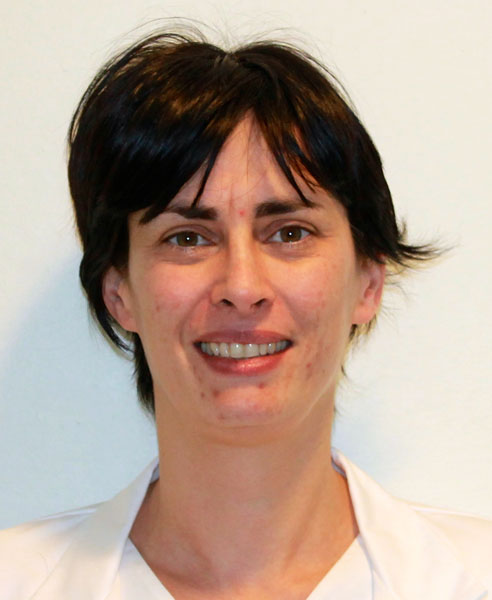NK cells specifically TCR-dressed to kill cancer cells
Nadia Mensali1, Pierre Dillard1, Michael Hebeisen2, Susanne Lorenz3, Theodossis Theodossiou4, Marit Renee Myhre1, Anne Fåne1, Gustav Gaudernack5, Gunnar Kvalheim1, June Helen Myklebust5, 6, Else Marit Inderberg1, Sébastien Wälchli1
1Department of Cellular Therapy, Oslo University Hospital-The Norwegian Radium Hospital, Oslo, Norway, 2Centre Universitaire Hospitalier Vaudois, University of Lausanne, Lausanne, Switzerland, 3Department of Core Facilities, Institute for Cancer Research, Oslo University Hospital-The Norwegian Radium Hospital, Oslo, Norway, 4Department of Radiation Biology, Institute for Cancer Research, Oslo University Hospital-The Norwegian Radium Hospital, Oslo, Norway, 5Department of Cancer Immunology, Institute for Cancer Research, Oslo University Hospital-The Norwegian Radium Hospital, Oslo, Norway, 6 Centre for Cancer Biomedicine,University of Oslo, Oslo, Norway
Adoptive T-cell transfer of therapeutic TCR relies on modifying the patient’s own T cells ex vivo and re-injecting them. The infusion of T cells in a tailor-made setting involves two costly steps: isolation by leukapheresis and transformation of the cells to redirect them. In some cases the manufacturing time might be longer than the life expectancy of the patient. A way to overcome the preparation of the patient’s own T cells is to use universal ready-made cells. For this purpose we exploited the FDA approved Natural killer (NK) cell line, NK-92, and showed that it can exploit TCRs and be turned into a T cell-like by simply reconstituting the CD3 signaling complex, which is necessary for proper TCR targeting to the plasma membrane and to transmit TCR signaling upon target binding.
The TCR-NK cells were modified to express two therapeutic TCRs; the Radium-1 TCR, isolated from a treated cancer patient, specific for a TGFbRII frameshift mutation peptide and the DMF-5 Melan A specific TCR. The TCR-redirected cell line, named TCR-NK-92, shown to mimic primary redirected T cells phenotypically, metabolically and functionally while retaining its NK cell effector functions. This TCR-NK-92 was functional and able to sustain TCR-pMHC specific cytotoxic functions both in vitro and in vivo. Furthermore, gene expression analysis demonstrated that TCR-NK-92 has acquired a T cell-like gene profile.
Our results provide a novel means to indefinitely produce TCR-redirected lymphocytes at lower cost and with similar therapeutic efficacy as redirected T cells and suggest that an NK cell line could be used as the source for off-the-shelf TCR-based cancer immunotherapy.
Dissecting T-cell responses in vaccinated, long- term surviving glioblastoma patients
Sébastien Wälchli1, Igor Snapkov2, Nadia Mensali1, Birthe Mikkelsen Saberniak1, Hedvig Vidarsdotter Juul1, Gunnar Kvalheim1, Einar Vik-Mo3,4, Victor Greiff 2, Else Marit Inderberg1
1Department of Cellular Therapy, Oslo University Hospital-The Norwegian Radium Hospital, Oslo, Norway, 2Department of Immunology, Oslo University Hospital-Rikshospitalet, Oslo, Norway, 3Department of Neurosurgery, Oslo University Hospital-Rikshospitalet, Oslo, Norway, 4Faculty of Medicine, University of Oslo, Oslo, Norway.
Several immunotherapeutic strategies are under investigation in glioblastoma (GBM), but have not yet reached their full potential.
A clinical trial investigating dendritic cell (DC)-based vaccine targeting cancer stem cells (CSC) in GBM was performed over 4 years (NCT00846456). Autologous CSCs were expanded in vitro as tumor spheres and their amplified mRNA, in addition to mRNA encoding defined universal tumour antigens telomerase and survivin, were transfected into monocyte-derived autologous DCs. DC vaccines were injected intradermally at specified intervals and immune responses induced by vaccination were identified in most patients.
Glioblastoma (GBM) is the most frequent and aggressive primary brain tumour in adults with a median survival of 12–15 months. Three of the vaccinated patients were long term survivors (>6 years) and we therefore decided to further analyze T-cell responses in these patients.
In one of the patients, both survivin- and hTERT-specific immune responses were detected post-vaccination. Survivin-specific CD4+ T-cell clones from peripheral blood were isolated. We found that HLAII-restricted TCRs isolated from these clones and expressed in donor T cells were functional in both CD4+ and, surprisingly, in CD8+ T cells lacking the CD4 co-receptor , producing TNF-α and IFN-γ upon recognition of cognate peptide.
T cells were also isolated from cerebrospinal fluid (CSF) and a tumour biopsy was taken >5 years after the start of vaccination. CD4+ T cells from CSF recognised human cytomegalovirus (CMV) and displayed an effector memory phenotype with a few dominant T-cell clones. Tumour infiltrating lymphocytes (TIL) were effector memory cells, predominantly CD4+ T cells and 80% of the TILs harboured the same TCR as shown by TCR high-throughput sequencing (TCR-seq).
TCR-seq showed substantial overlap between the TCR repertoire in PBMCs and leukapheresis product in pre-and post-vaccination samples. The only sample showing no detectable overlap in TCR repertoire with any other samples was the CSF and the TILs demonstrated high clonality and reduced overlap with pre-vaccination samples. Work is still ongoing to determine the antigen specificity of these T cells and will provide further insight into how a successful anti-tumour response is constituted in GBM and can lead to the design of more efficient immunotherapy approaches.
Improvement of CD19 CAR target restriction through combinatorial design
Hakan Köksal, Pierre Dillard, Gunnar Kvalheim, Erlend B. Smeland, June H. Myklebust, Else Marit Inderberg, Sébastien Wälchli
The use of CAR T cells targeting the B-lymphocyte antigen CD19 has led to remarkable clinical results. However, since CD19 CAR-T cells eliminate all B-lineage cells, patients suffer from impaired humoral immune response with increased susceptibility to severe infections. Due to allelic exclusion of immunoglobulin (Ig) genes, mature B cells will express either Igκ or Igλ light chains. Thus targeting Igκ+ B cell tumors will spare healthy B cells expressing Igλ. We designed a second-generation CAR targeting Igκ, IGK CAR, and compared its specificity and efficacy with CD19 CAR. Although effective, we noticed a loss of activity of IGK CAR in the presence of serum IgG, which could have a negative impact on the injected IGK CAR T cells. Since CD19 CAR is not sensitive to environmental factors, we designed various combinatorial CAR constructs to obtain a molecule keeping the CD19 CAR efficacy and IGK CAR selectivity. The Kz-19BB design, combining a CD19 CAR containing a 4-1BB costimulatory domain with an IGK CAR containing CD3zeta stimulatory domain, maintained Igκ selective killing even in the presence of soluble IgG. The combinatorial construct could efficiently reproduce the outcome of a single second generation CAR in terms of signalling and the resulting cellular modifications (killing and cytokine release). Our results demonstrate that a combinatorial CAR approach can maintain target selectivity of IGK CAR, hence improving CD19 CAR performance against Igκ+ malignancies in clinical settings.
A combinatorial IGL-CD19 CAR provokes unpredicted cytotoxicity
Elizabeth Baken1, Hakan Köksal1, David Warren2, Else Marit Inderberg1, Sébastien Wälchli1
1Oslo University Hospital Radiumhospitalet, Cell Therapy, Oslo, Norway, 2Oslo University Hospital, Central Lab, Oslo, Norway
Chimeric Antigen Receptor (CAR) therapy is a promising treatment for cancer. The FDA and the EU approved a commercialized treatment of B-cell malignancies targeting CD19 antigen. However, targeting CD19 can result in B-cell aplasia, which leads to increased susceptibility to infections that can be fatal. Since malignant B cells are mostly restricted in the expression of one Immunoglobulin (Ig) light chain allele, Ig-Kappa (Igκ) or Ig-Lambda (Igλ), Igκ positive normal cells can be spared by targeting the Igλ positive tumour cells, and vice versa. We extracted the sequence encoding the antigen-binding parts of an anti-Igλ antibody and designed a second-generation CAR construct (IGL CAR). IGL CAR redirected peripheral blood T cells were tested in various in vitro assays with target cells and compared with the clinical CD19 CAR (clone fmc63). IGL CAR T cells demonstrated specific killing and cytokine release against Igλ+ cells, such as MAVER-1, while no response was detected against Igκ+ cell lines such as BL-41. Since anti-Ig CARs are known to react with serum Ig, we improved IGL CAR by combining it to CD19 CAR. The CD19 CAR moiety was fused to 4-1BB signaling domain, which was expected to restrict recognition to double positive cells. In addition, we confirmed that, unlike IGL CAR-CD3z, CD19 CAR-4-1BB was not able to trigger T-cell stimulation alone. However, the combinatorial CAR demonstrated an extremely potent killing of all target B cells, independently of the BCR type. This was surprising as we did not observe this phenotype with our anti-Igκ CAR (IGK CAR). When we tested IGL-CD19 CAR specificity, we noticed no response when co-cultured with Igλ/CD19 double negative cells, therefore CD19 recognition was necessary and CD19 CAR was sufficient to provoke a cytotoxic effect by the combinatorial CAR. Thus, compared to IGK-CD19 CAR, IGL-CD19 CAR showed an extremely potent yet single target dependent signaling, which suggests that although elegant, combinatorial approach should be used with caution.




